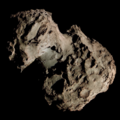 The comet on 5 March 2024 by ZTF | |
| Discovery [1] | |
|---|---|
| Discovered by | Near Earth Asteroid Tracking |
| Discovery date | March 11, 2001 |
| Designations | |
| P/2001 J1, P/2008 T5 | |
| Orbital characteristics [2] | |
| Epoch | September 21, 2021 (2459478.5) [2] |
| Aphelion | 6.811 AU |
| Perihelion | 0.9325 AU |
| Semi-major axis | 3.8716 AU |
| Eccentricity | 0.7591 |
| Orbital period | 7.618 a 2782.5 d |
| Inclination | 10.186 ° |
| 198.343° | |
| Argument of periapsis | 272.996° |
| Last perihelion | 31 January 2024 [2] |
| TJupiter | 2.449 |
| Earth MOID | 0.140 AU |
207P/NEAT is a periodic Jupiter-family comet with an orbital period of 7.62 years. It was discovered by Near Earth Asteroid Tracking (NEAT) on 11 March 2001. [1]
The comet upon discovery appeared diffuse, with the coma having a diameter of 8 to 15 arcseconds and its apparent magnitude was estimated to be 19.9 by NEAT and 17.1 – 17.3 by other observers. [1] After further observations it was determined that it is a short period comet, with an orbital period of about 7.5–7.9 years which has a rough similarity with that of the lost comet Biela according to Shuichi Nakano. It was also identified as a faint asteroidal object that was detected by Arianna Gleason of Spacewatch on 7 October 2000, but it wasn't followed-up. [3]
The comet was recovered on 15 October 2008 by K. Kadota using a CCD camera mounted on a 25-cm reflector telescope. The comet had a coma diameter of 0.5-0.6 arcminutes and a central condensation with no tail. The apparent magnitude was estimated to be 16.4. [4] After the recovery the comet was given the permanent designation 207P. [5] During the 2024 apparition and comet approached Earth at a distance of 0.2198 AU (32.88 million km) on 5 March, [2] and brightened to an apparent magnitude of around 14. [6] On 6 February 2045 the comet will approach Earth at a distance of 0.1566 AU (23.43 million km). [2]
The comet lies near to a 3:2 inner orbital resonance with Jupiter and could have been a Hilda asteroid. The comet also experiences large periodic oscillations in perihelion distance and inclination, ranging from 0.94 AU and 10 degrees of inclination to 3.8 AU and 50 degrees of inclination through the Kozai mechanism the last 10,000 years. [7]
The radius of the nucleus of the comet is estimated to be 0.69 kilometers. [7]

